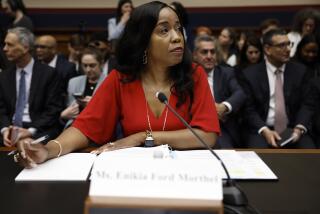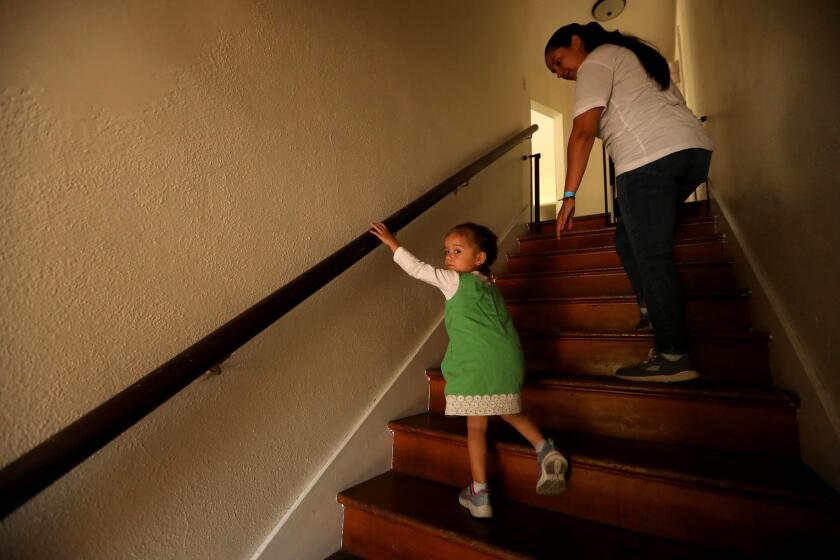High School Vocational Classes Are Stalling Out
Standing on either side of the gleaming Volvo S60 Turbo, the two students anxiously awaited the judge’s signal.
An amplified voice was carried through the convention hall: “Ten, nine, eight ... “
Nick Young, stocky and soft-spoken, glanced through his protective eyewear at Team Volkswagen to the right and Team Buick to the left.
“Seven, six, five .... “
Bill Paddock, with his greased-back hair, tattoos and bravado, took a final inventory of the tools, manuals and computers they would use over the next three hours to identify and fix dozens of “bugs” riddling the lifeless car.
“Four, three, two, one.”
Voices from 37 teams burst the tension. Paddock and Young huddled one last time with their high school auto technology teacher, Robert McCarroll.
His firm orders: “Stay calm.”
*
If there had been any doubt, qualifying for a spot at the National Automotive Technology Competition in New York City confirmed for Paddock and Young that their futures are in automobiles. More interested in wheel alignment than SAT vocabulary, they are two of the more than 1 million American high school graduates who will not attend college this fall.
Unlike many other teenagers who end their education in high school, however, Paddock and Young will move on to advanced auto training at a trade school.
That and the training they received at the Auto Technology Academy at San Clemente High School put the two at the center of a debate in California and nationwide over what role blue-collar trades should play in the public schools.
For decades, vocational education has played second fiddle to classroom academics. With the “Nation at Risk” school-improvement initiative in 1983, officials launched an effort to raise academic standards. Concerned that American students were losing ground to their counterparts in Japan, Germany and other countries, politicians and classroom experts called for increased academic rigor, especially in math and science.
The trend intensified with the current, federal No Child Left Behind law, which holds schools accountable for student performance on high-stakes, standardized tests.
Many education officials would like to go even further. California Superintendent of Public Instruction Jack O’Connell, for example, has argued vigorously for requiring all high school students to pass courses that would allow them to enroll at a state university.
“It’s time to change high schools from the inside out, to focus
The schools chief acknowledges that vocational education has been neglected in California but insists his push for tougher academics does not need to come at its expense. He envisions vocational classes with enough academic rigor that they would satisfy university admission standards while still preparing students for the workplace.
Supporters of vocational education aren’t buying it. They decry what they say is an obsession with college preparation that ignores the needs of the roughly 38% of the country’s high school seniors who do not enroll in two-year or four-year colleges and who might benefit from vocational training.
“Clearly, there are a set of academic skills everyone needs to be successful in our society,” said James Stone, director for the National Research Center for Career and Technical Education. “But does every child need to study trigonometry?”
“The problem is that many people look at college as the goal,” said McCarroll, the San Clemente teacher who runs one of the relatively few programs in California that blends academics with traditional vocational training. “College is not the goal. It is only one means to an end, and the end is these kids’ careers.”
“We are trying to shove a lot of square pegs into round holes.”
*
In high schools across the country and in California, comprehensive trade programs have declined in number and in quality. At many school districts, as the focus has turned increasingly toward core academics, such programs have either become dumping grounds for poorly performing students or have disappeared altogether.
In 1975, when McCarroll taught his first class, San Clemente’s vocational program cranked at full-tilt. Eight full-time teachers offered beginner, intermediate and advanced classes in auto shop, wood and metal working, drafting and electronics. “This whole darn area went all day long,” he said with a sweep of his hand. “It was so noisy you could barely hear yourself think. Now I’m the only one left.”
In 1987, the earliest year for which the state has data, nearly 27% of California high school students were enrolled in at least one industrial vocational education class. Today, only 15% of students are taking such classes.
Over virtually the same span, membership in the California Industrial Technology Education Assn., which includes trade instructors, has plummeted from 5,000 to 350.
Several factors account for the declining numbers. Until the mid-1980s in many school districts, minority students were often disproportionately shunted toward vocational education classes. Although recent research indicates that such race-based tracking has largely been eliminated, Stone said, urban districts continue to encounter minority parents reluctant to enroll their children in vocational classes.
A changing economy that includes growing healthcare and technology sectors and declining manufacturing industries has also made some vocational program obsolete.
More pressing, however, is money. Running equipment-dependent vocational programs is expensive, and in the competition for classroom dollars, those programs fade on priority lists.
“We have had to make hard decisions,” said James A. Fleming, superintendent of the Capistrano Unified School District, where Young and Paddock attend. “Do we put a wood shop and machine shop in a new high school, or more academic classrooms? We have backed off from those trade programs.”
California has developed regional training programs that offer day and evening classes for high school students and adults at area campuses. Vocational education experts praise the programs but agree that because of age restrictions and limited access, they are no substitute for a high school trade-skills curriculum.
The state does have some high school programs designed to upgrade vocational education. McCarroll’s is one. Opened in 1998, the auto tech academy operates as a self-contained school within San Clemente High. Students satisfy basic graduation requirements and receive three years of increasingly complex auto classes and on-the-job training.
The auto program is one of 290 state-supported “partnership academies” in which school districts and businesses -- in this case auto dealers and mechanics -- team up to offer programs that train students.
“It is such a mammoth mission to put quality men and women in this industry,” said Larry Cummings, president of Automotive Youth Education Systems, the group formed by auto makers to work with school districts on vocational programs. “We’ve got to have a school system that can deliver this type of curriculum to the students.”
But while California’s academies are one of the country’s more ambitious vocational education initiatives, there are still too few to meet student needs. Each year, McCarroll turns students away -- often as many as he accepts. Moreover, relatively few of the academy programs teach conventional trade skills such as agriculture, carpentry and auto mechanics, focusing instead on white-collar skills such as business, computer technology and health science.
Paddock and Young “are the exception, rather than the rule,” in receiving state-of-the-art training for blue-collar work, said Stone. “We are becoming a nation of test-takers,” he said. “But we won’t have kids that understand the world around them or know the skills that the labor market is saying are needed.”
Paddock and Young say they feel fortunate to have found the auto academy. Early on, the two students -- and their parents -- recognized that they were not meant for college. Barely getting by on poor grades and minimal motivation, both said they probably would have dropped out of school were it not for McCarroll and the sense of purpose they discovered at the academy.
“I’m just not the college kind of person,” said Paddock, who struggles with dyslexia. “I’m not going to go to English class and history class. It’s not appealing to me.
“I think with these,” he said, holding up his hands. “If there is something broken, I can figure out how to fix it.”
*
An hour into the competition, Paddock and Young had made some small finds -- a blown fuse in the air-conditioner, a faulty headlight -- but large problems remained.
The team’s “engine guy,” Paddock was elbow deep in the Volvo’s high-tech power plant, perplexed that he still couldn’t start it.
He emerged and hooked a laptop computer to the car’s ignition system to run diagnostic tests. Paddock reached for a digital meter on a hunch that electrical power was not getting through to the ignition sensor.
Meanwhile, Young, “the body guy,” had nearly crawled into the trunk in an attempt to get the rear defogger working.
Somewhere in the room, a competing team’s automobile roared to life.
Time was running out.
*
The future of vocational education remains uncertain.
A state panel is working on standards and curriculum for vocational education programs, but O’Connell concedes that school districts will not be obligated to follow its recommendations.
He offers few details on how school districts will be able to fit both tougher academics and strong vocational programs into an already-packed school year.
Bernie Norton, who heads the state’s high school initiatives office and is overseeing the panel, said it would be difficult to build enough flexibility into school schedules and find the money to fund extensive projects.
The issue confounds educators nationwide.
Although successful vocation programs dot each state, no state is doing an adequate job overall of preparing vocational students, said Assistant Secretary of Education Susan Sclafani, who oversees the federal government’s vocational training programs.
Without more trade programs like McCarroll’s academy, disaffected students will continue to drop out or head toward college life for which they are ill-suited, she said.
Congress, meanwhile, is debating the re-authorization of a federal vocational education funding bill.
Sclafani said she wants to hold states more accountable for the success of career programs and has proposed withholding some funds from states until they improve.
*
The final half-hour slipped away. Paddock gave up trying to get the car started without dismantling it. To test the Volvo’s spark plugs, the cumbersome turbo tube had to come off.
Young returned to the still-broken defogger, and Paddock set to work uncovering the plugs. Working in silence, they kept their poise, resigned that they probably would not start the car -- the ultimate goal of the competition.
The final minute ticked off, and the two stepped back. For a moment, they were disappointed that they wouldn’t win a new car, expensive tools or tuition to training programs that were among the prizes. But the sting passed quickly.
“It’s been good for us,” Young said. “We are going to run into these types of problems as mechanics. It gives us a taste of what we’ll be doing.”
“A lot of people underestimated me,” Young said. “It feels good to have accomplished something in school. And now I know what I want to do with my life. I’m lucky enough to have found auto, liked it and been decent at it. My talents came through.”
More to Read
Start your day right
Sign up for Essential California for news, features and recommendations from the L.A. Times and beyond in your inbox six days a week.
You may occasionally receive promotional content from the Los Angeles Times.







